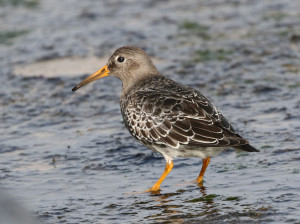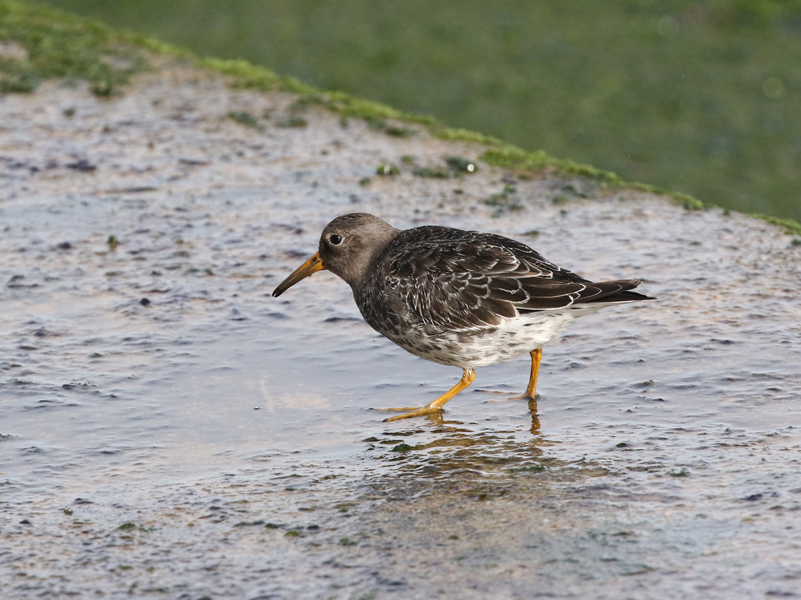
The arrival of some birds really gives you a sense of the time of the year and for me when autumn comes around in UK I look forward to seeing Purple Sandpiper. This handsome little wader breeds within the arctic circle but at this time of the year they move further south and small numbers of them spend the winter on rocky coasts in Britain, frequently using the base of harbour walls, rocky slipways and other man-made structures that are submerged at high tide but exposed at low tide for feeding upon. Purple Sandpipers are scarce enough to me that I am not over familiar with them but at the same time I frequently saw small groups of them at Bridlington Harbour in East Yorkshire when I was at university, so that when I catch up with them it feels like meeting an old friend.
Last week I was lucky enough to make a short trip to Suffolk and spend an afternoon watching a small number of Purple Sandpipers feeding on rocky sea defences at Southwold, a short distance north of the pier. One of the delights of Purple Sandpipers is that they will often be so busy feeding that they ignore the close proximity of humans so that I was able to sit quietly and watch them go about their business until they were actually feeding at my feet. What a way to watch these smart little birds.
When I arrived at Southwold I walked up the coast a little, away from where the greatest human disturbance was as many species of shorebird are very sensitive to this. I found a way down some stairs onto the coastal defences and scanned up and down to see if I could find any Purple Sandpipers. No luck at first so I lowered my binoculars to find that a group of three Purple Sandpipers were feeding right in front of me! This gave me the perfect opportunity to photograph them and make a video of them.
I read in Handbook of the Birds of the Western Palearctic, Volume III that Purple Sandpipers form flocks of up to 12 birds in the UK, with groups rarely exceeding that number. In support of this I found another bird feeding alone a few hundred metres away as well as one more feeding among a group of Ruddy Turnstones on some rocks at a harbour a few miles away.
Back near Southwold pier I found a place to sit that wasn’t too wet and quietly watched the Purple Sandpipers go about their business as the tide went out and exposed more sand and rocks.
Although they were occasionally scared onto the rocks by passing walkers and the odd attack by Turnstones they always quickly returned to the weed-encrusted seafront to feed again. As I was sitting more or less motionless this meant that the birds came right up to me, giving me extraordinarily close up views of them and at one point they were actually feeding between my boots; too close for me to continue videoing them.
The name Purple Sandpiper comes from the fact that when seen in good light some of the feathers on the back and wings have a purplish sheen and I was able to see this in one of the birds when the sun hit it. You can see a hint of the purple sheen in this photograph.
I was recently made aware that Purple Sandpipers breed in higher altitude areas, mostly within or close to the Arctic Circle, at low densities and are quite tricky to observe. This is in complete contrast to their wintering behaviour and while I would really like to see them on their breeding grounds I will have to enjoy watching them on the rocky coasts of Britain this autumn.
If you are someone who enjoys watching waders then I highly recommend getting hold of a copy of Shorebirds: An Identification Guide to the Waders of the World, there are usually some cheap second hand copies available on Amazon.


 October 21st, 2020
October 21st, 2020  Nick
Nick 









 Posted in
Posted in  Tags:
Tags: 









